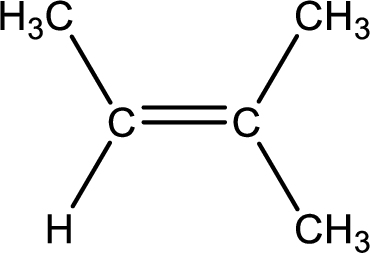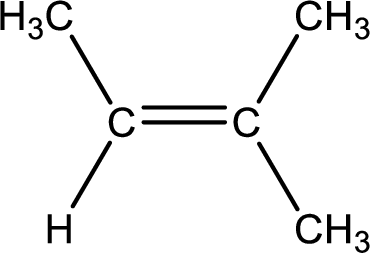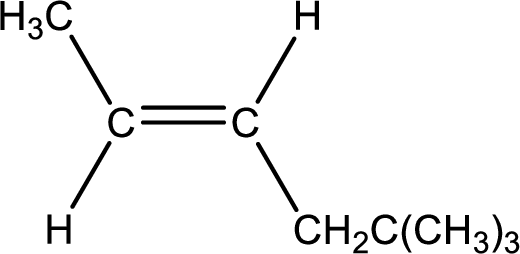
GENERAL,ORGANIC,+BIOCHEMISTRY
10th Edition
ISBN: 9781260148954
Author: Denniston
Publisher: RENT MCG
expand_more
expand_more
format_list_bulleted
Question
Chapter 11.3, Problem 11.8Q
(a)
Interpretation Introduction
Interpretation:
Given compound has to be named according to

Concept Introduction:
A common nomenclature of naming organic compounds has been developed by IUPAC. By usage of this nomenclature or rules, memorizing of names of organic compounds is not necessary.
IUPAC rules for naming
There are about five rules that has to be followed for naming an alkene and an
- The longest continuous carbon chain in the compound that contains double bond or triple has to be identified. This is known as parent compound.
- Suffix “–ane” (in name of
alkane ) is replaced with “-ene” for alkene or “-yne” for alkyne. - Numbering has to be done so that the lowest number is given to the double or triple bond.
- Naming and numbering has to be given for each atom or group that is attached to the parent chain. Numbering has to be done in a way that substituents get the least numbering.
- If the alkenes have more than one double bond they are called as alkadienes (two double bonds) or alkatrienes (three double bonds). Appropriate suffix has to be used depending on the number of multiple bonds present in the compound.
- Stereoinformation has to be included in the IUPAC name in the starting. This can be either cis- or trans- for alkene.
(b)
Interpretation Introduction
Interpretation:
Given compound has to be named according to IUPAC nomenclature.

Concept Introduction:
Refer part (a).
(c)
Interpretation Introduction
Interpretation:
Given compound has to be named according to IUPAC nomenclature.

Concept Introduction:
Refer part (a).
Expert Solution & Answer
Want to see the full answer?
Check out a sample textbook solution
Students have asked these similar questions
What would be the major product of the following reaction? Please include a detailed explanation of what is happening in this question. Include steps and a drawing to show this reaction proceeds and how the final product is formed. The correct answer is B. I put answer D and I don't really understand what is going on in the question.
What is the product of the following reaction? Please explain what is happening in this question. Provide a detailed explanation and a drawing showing how the reagent is reacting with the catalysts to product the correct product. The correct answer is B.
What is the missing intermediate 1 and the final product 2. Please include a detailed explanation explaining the steps of malonic ester synthesis. Please include drawings of the intermediate and how it occurs and how the final product is former.
Chapter 11 Solutions
GENERAL,ORGANIC,+BIOCHEMISTRY
Ch. 11.2 - Name each of the following alkenes and alkynes...Ch. 11.2 - Prob. 11.2PPCh. 11.2 - Prob. 11.1QCh. 11.2 - Prob. 11.2QCh. 11.3 - Prob. 11.3PPCh. 11.3 - Prob. 11.4PPCh. 11.3 - Prob. 11.5PPCh. 11.3 - Prob. 11.3QCh. 11.3 - Prob. 11.4QCh. 11.3 - Prob. 11.5Q
Ch. 11.3 - Draw each of the cis-trans isomers in Question...Ch. 11.3 - Prob. 11.7QCh. 11.3 - Prob. 11.8QCh. 11.5 - Prob. 11.6PPCh. 11.5 - Prob. 11.7PPCh. 11.5 - Prob. 11.9QCh. 11.5 - Write balanced equations for the hydrogenation of...Ch. 11.5 - Prob. 11.11QCh. 11.5 - Prob. 11.12QCh. 11.5 - Prob. 11.8PPCh. 11.5 - Prob. 11.13QCh. 11.5 - Prob. 11.14QCh. 11.5 - Prob. 11.15QCh. 11.5 - Prob. 11.16QCh. 11.5 - Prob. 11.9PPCh. 11.5 - Prob. 11.17QCh. 11.5 - Prob. 11.18QCh. 11.5 - Prob. 11.19QCh. 11.5 - Prob. 11.20QCh. 11.5 - Write a balanced equation for the hydrobromination...Ch. 11.6 - Name the following compounds using the IUPAC and...Ch. 11.6 - Prob. 11.21QCh. 11.6 - Prob. 11.22QCh. 11 - Prob. 11.23QPCh. 11 - Prob. 11.24QPCh. 11 - Prob. 11.25QPCh. 11 - Prob. 11.26QPCh. 11 - Prob. 11.27QPCh. 11 - Prob. 11.28QPCh. 11 - Prob. 11.29QPCh. 11 - Prob. 11.30QPCh. 11 - Prob. 11.31QPCh. 11 - Prob. 11.32QPCh. 11 - Prob. 11.33QPCh. 11 - Prob. 11.34QPCh. 11 - Prob. 11.35QPCh. 11 - Prob. 11.36QPCh. 11 - Prob. 11.37QPCh. 11 - Prob. 11.38QPCh. 11 - Prob. 11.39QPCh. 11 - Prob. 11.40QPCh. 11 - Prob. 11.41QPCh. 11 - Prob. 11.42QPCh. 11 - Prob. 11.43QPCh. 11 - Prob. 11.44QPCh. 11 - Prob. 11.45QPCh. 11 - Prob. 11.46QPCh. 11 - Which of the following alkenes can exist as...Ch. 11 - Prob. 11.48QPCh. 11 - Prob. 11.49QPCh. 11 - Prob. 11.50QPCh. 11 - Prob. 11.51QPCh. 11 - Prob. 11.52QPCh. 11 - Prob. 11.53QPCh. 11 - Prob. 11.54QPCh. 11 - Prob. 11.55QPCh. 11 - Prob. 11.56QPCh. 11 - Prob. 11.57QPCh. 11 - Prob. 11.58QPCh. 11 - Prob. 11.59QPCh. 11 - Prob. 11.60QPCh. 11 - Prob. 11.61QPCh. 11 - Prob. 11.62QPCh. 11 - Prob. 11.63QPCh. 11 - Prob. 11.64QPCh. 11 - Prob. 11.65QPCh. 11 - Prob. 11.66QPCh. 11 - Prob. 11.67QPCh. 11 - Prob. 11.68QPCh. 11 - Prob. 11.69QPCh. 11 - Prob. 11.70QPCh. 11 - Prob. 11.71QPCh. 11 - Prob. 11.72QPCh. 11 - Prob. 11.73QPCh. 11 - Prob. 11.74QPCh. 11 - Prob. 11.75QPCh. 11 - Prob. 11.76QPCh. 11 - Prob. 11.77QPCh. 11 - Prob. 11.78QPCh. 11 - Prob. 11.79QPCh. 11 - Prob. 11.80QPCh. 11 - Prob. 11.81QPCh. 11 - Prob. 11.82QPCh. 11 - Prob. 11.83QPCh. 11 - Write an equation for the addition reaction that...Ch. 11 - Prob. 11.85QPCh. 11 - Draw the structure of each of the following...Ch. 11 - Prob. 11.87QPCh. 11 - Prob. 11.88QPCh. 11 - Prob. 11.89QPCh. 11 - Prob. 11.90QPCh. 11 - Prob. 11.91QPCh. 11 - Prob. 11.92QPCh. 11 - Draw each of the following compounds, using...Ch. 11 - Prob. 11.94QPCh. 11 - Prob. 11.95QPCh. 11 - Prob. 11.96QPCh. 11 - Prob. 11.97QPCh. 11 - Prob. 11.98QPCh. 11 - Prob. 11.99QPCh. 11 - Prob. 11.100QPCh. 11 - Prob. 11.101QPCh. 11 - Prob. 11.102QPCh. 11 - Prob. 11.103QPCh. 11 - What biological molecules contain purine rings?
Ch. 11 - Prob. 1MCPCh. 11 - Prob. 3MCPCh. 11 - Prob. 5MCPCh. 11 - Prob. 6MCPCh. 11 - Prob. 7MCPCh. 11 - Prob. 8MCPCh. 11 - Prob. 9MCPCh. 11 - Prob. 10MCP
Knowledge Booster
Learn more about
Need a deep-dive on the concept behind this application? Look no further. Learn more about this topic, chemistry and related others by exploring similar questions and additional content below.Similar questions
- What would be the reagents and conditions above and below the arrow that will complete the proposed acetoacetic ester synthesis? If it cannot be done efficiently, then I will choose that answer. There could be 2 or 4 reagents involved. Please provide a detailed explanation and drawings showing how it would proceed with the correct reagents.arrow_forwardFor benzene, the ∆H° of vaporization is 30.72 kJ/mol and the ∆S° of vaporization is 86.97 J/mol・K. At 1.00 atm and 228.0 K, what is the ∆G° of vaporization for benzene, in kJ/mol?arrow_forwardThe reaction Q(g) + R(g) → Z(l) is shown to be exothermic. Which of the following is true concerning the reaction. it is spontaneous only at High T, it is spontaneous at low T it is nonspontaneous at all T it is spontanrous at all T. it is non spontaneous only at low T.arrow_forward
- The reaction Q(g) + R(g) → Z(l) is shown to be exothermic. Which of the following is true concerning the reactionarrow_forwardWhich of the following has the largest standard molar entropy, S° (298.15 K) He H2 NaCl KBr Hgarrow_forwardWhich of the following is true for a particular reaction if ∆G° is -40.0 kJ/mol at 290 K and –20.0 kJ/mol at 390 K?arrow_forward
arrow_back_ios
SEE MORE QUESTIONS
arrow_forward_ios
Recommended textbooks for you
 ChemistryChemistryISBN:9781305957404Author:Steven S. Zumdahl, Susan A. Zumdahl, Donald J. DeCostePublisher:Cengage Learning
ChemistryChemistryISBN:9781305957404Author:Steven S. Zumdahl, Susan A. Zumdahl, Donald J. DeCostePublisher:Cengage Learning ChemistryChemistryISBN:9781259911156Author:Raymond Chang Dr., Jason Overby ProfessorPublisher:McGraw-Hill Education
ChemistryChemistryISBN:9781259911156Author:Raymond Chang Dr., Jason Overby ProfessorPublisher:McGraw-Hill Education Principles of Instrumental AnalysisChemistryISBN:9781305577213Author:Douglas A. Skoog, F. James Holler, Stanley R. CrouchPublisher:Cengage Learning
Principles of Instrumental AnalysisChemistryISBN:9781305577213Author:Douglas A. Skoog, F. James Holler, Stanley R. CrouchPublisher:Cengage Learning Organic ChemistryChemistryISBN:9780078021558Author:Janice Gorzynski Smith Dr.Publisher:McGraw-Hill Education
Organic ChemistryChemistryISBN:9780078021558Author:Janice Gorzynski Smith Dr.Publisher:McGraw-Hill Education Chemistry: Principles and ReactionsChemistryISBN:9781305079373Author:William L. Masterton, Cecile N. HurleyPublisher:Cengage Learning
Chemistry: Principles and ReactionsChemistryISBN:9781305079373Author:William L. Masterton, Cecile N. HurleyPublisher:Cengage Learning Elementary Principles of Chemical Processes, Bind...ChemistryISBN:9781118431221Author:Richard M. Felder, Ronald W. Rousseau, Lisa G. BullardPublisher:WILEY
Elementary Principles of Chemical Processes, Bind...ChemistryISBN:9781118431221Author:Richard M. Felder, Ronald W. Rousseau, Lisa G. BullardPublisher:WILEY

Chemistry
Chemistry
ISBN:9781305957404
Author:Steven S. Zumdahl, Susan A. Zumdahl, Donald J. DeCoste
Publisher:Cengage Learning

Chemistry
Chemistry
ISBN:9781259911156
Author:Raymond Chang Dr., Jason Overby Professor
Publisher:McGraw-Hill Education

Principles of Instrumental Analysis
Chemistry
ISBN:9781305577213
Author:Douglas A. Skoog, F. James Holler, Stanley R. Crouch
Publisher:Cengage Learning

Organic Chemistry
Chemistry
ISBN:9780078021558
Author:Janice Gorzynski Smith Dr.
Publisher:McGraw-Hill Education

Chemistry: Principles and Reactions
Chemistry
ISBN:9781305079373
Author:William L. Masterton, Cecile N. Hurley
Publisher:Cengage Learning

Elementary Principles of Chemical Processes, Bind...
Chemistry
ISBN:9781118431221
Author:Richard M. Felder, Ronald W. Rousseau, Lisa G. Bullard
Publisher:WILEY
07 Physical Properties of Organic Compounds; Author: Mindset;https://www.youtube.com/watch?v=UjlSgwq4w6U;License: Standard YouTube License, CC-BY